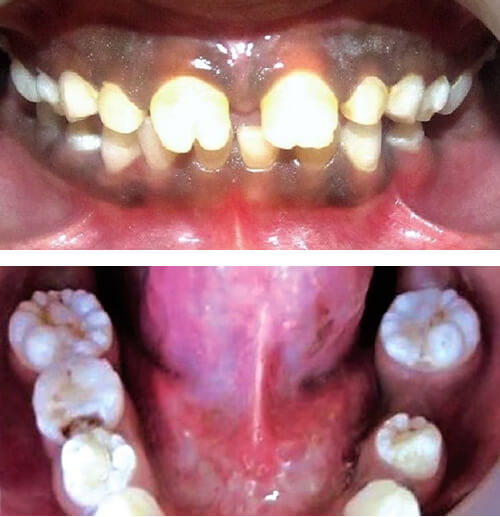Rare and surprising conditions you probably didn’t know existed
Key Takeaways
Some days, it may feel like you've seen it all—but deep down you know you haven't. Here are five conditions you may never have heard of and are probably unlikely to encounter. But, then again, you never know. When you hear hoofbeats, think horses—but don't forget that zebras still exist.
Hair growing like fingernails

(Photo: www.cure4sai.com)
Since 2009, a young woman in Memphis, TN, has been suffering from a mysterious skin condition that causes fingernail-like growths to sprout from the hair follicles all over her body. Physicians treating her were baffled. Expert dermatologists at Johns Hopkins Medical Center, Baltimore, MD, pronounced her case as the only one on record.
It started when the young woman suffered a massive asthma attack. The local emergency department gave her steroids, which triggered an allergic reaction. Soon after, her skin began to itch uncontrollably, and hard white spines started growing from her scalp and skin. Doctors at Johns Hopkins concluded she has an extremely rare form of disseminated porokeratosis—a condition in which each hair follicle produces dozens of the amount of keratin cells it normally should, which then combine to make fingernail-like spines instead of hair. The patient's doctors treated her with isotretinoin, which reversed many of her symptoms, but they continue to search for a cure.
Crying blood

(Photo: James R, et al. BMJ Case Rep. 2018.)
Le Chiffre, the fictional villain in the James Bond movie Casino Royale, had a peculiarity of weeping blood when he was stressed. But this rare condition—hemolacria—isn't the stuff of fiction.
Described as the production of bloody tears, hemolacria is often caused by trauma, disorders of the conjunctiva, lacrimal gland diseases, and more rarely by malignancy, epistaxis with regurgitation of blood from the nasal cavity, or malingering. But this rare disorder is also occasionally idiopathic—frustrating clinicians and patients alike. Although idiopathic hemolacria frequently resolves on its own, clinicians in one report inserted punctal plugs into the inferior puncta in two different patients with idiopathic bilateral hemolacria, which provided symptomatic relief.
Bobble-head doll syndrome

(Photo: Medical University of South Carolina)
Bobble-head doll syndrome is, unfortunately, exactly what it sounds like. It's a rare neurological disorder characterized by involuntary, rhythmic, nodding head movement that occurs about 2 to 3 times per second (2 Hz to 3 Hz), usually in an anterior-posterior direction. It typically develops in patients younger than 10 years old, although occurrences in older patients have been reported. Emotional stress aggravates head bobbing; however, the movement can be voluntarily diminished, and it stops altogether during sleep.
Despite its lighthearted and playful name, bobble-head doll syndrome almost always has a worrisome cause: a cystic lesion in the brain. The lesion occurs in or near the third ventricle, putting pressure on the adjacent neuronal structures. Despite knowing its location, researchers still don't know the exact cause of the syndrome. Currently, the only treatment method is endoscopic surgery to reduce the cyst, which allows the free flow of cerebrospinal fluid. Bobbing head movements should cease immediately after surgery.
Spontaneous toe amputation

Ainhum, otherwise called dactylolysis spontanea, is a condition in which a painful, fibrous constriction encircles typically the pinky toe at the base, which gradually causes spontaneous auto-amputation. The condition usually presents bilaterally in the fifth toe, but sometimes occurs in both the fourth and fifth toes. It rarely involves the big toe, and even more rarely occurs in fingers.
Ainhum (derived from an African word meaning "to saw" or "to cut") is most commonly reported among black people, often men, between ages 20 and 50 years in tropical and subtropical areas of South Africa and South America. The cause of the condition remains unknown, although some have hypothesized that ainhum may be related to trauma and walking barefoot. Medical management in the early stages of the condition includes topical or injectable corticosteroids, salicylate preparations, or retinoids, while surgical treatment can release the constricting fibrous band. In the later stages, surgical amputation of the toe is generally necessary.
Ainhum must be distinguished from pseudo-ainhum, which occurs secondary to acquired or congenital conditions or diseases. In particular, it should be differentiated from toe-tourniquet syndrome, a condition with similar appearance that has been publicized in the news lately.
Screwdriver incisors and mulberry molars

(Photos: Chowdhary N, et al. J Indian Soc Pedod Prev Dent. 2014.)
Although the colorfully named screwdriver incisors and mulberry molars may sound unfamiliar, they're manifestations of a condition you've likely learned about or seen clinically: congenital syphilis. In fact, malformed teeth are among the three elements (along with interstitial keratitis and sensorineural hearing loss) that make up Hutchinson's triad for identifying congenital syphilis.
Screwdriver incisors—more commonly called notched incisors or Hutchinson's teeth—appear as small, widely-spaced, peg-shaped, notched upper front teeth with thin discolored enamel. Mulberry molars have multiple cusps, resembling a mulberry.
Infants born with congenital syphilis may display characteristic signs and symptoms at birth, or they may be completely asymptomatic until clinical findings and/or infection are apparent. Congenital syphilis has been steadily declining in the United States for years, but the number of babies born with syphilis has taken a sharp increase recently. In 2017, the number of cases of congenital syphilis was the highest it's been in 20 years, according to the Centers for Disease Control and Prevention.